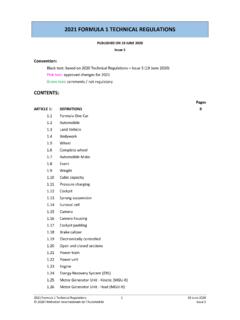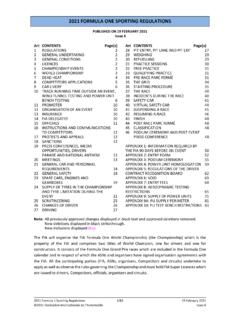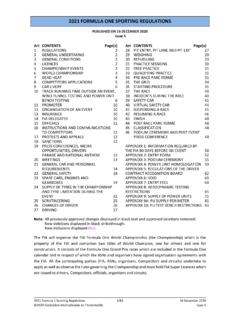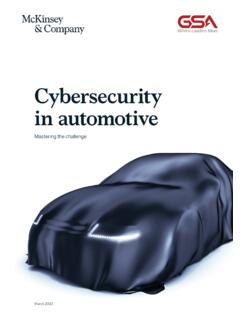Transcription of “Global reduction in CO2 emissions from cars: a consumer’s ...
1 1 Global reduction in CO2 emissions from cars: a consumer s perspective Policy recommendations for decision makers Context: the global agenda The international political response to climate change was initiated in Rio de Janeiro, Brazil, at the Earth Summit in 1992. The adopted convention set out a framework for action aimed at stabilising atmospheric concentrations of greenhouse gases (GHGs). Since then, CO2 emission reduction policies have driven the international policy agenda, with a particular emphasis in the transport sector: oil dependency and climate change are highly debated by governments and international decision-makers (UN Framework on Climate Change, UN- unece , European Commission); the automotive industry is requested to improve the environmental performance of its products; local authorities, particularly at urban level, are confronted with the issue of limiting the environmental impact of the growing demand for road transportation.
2 COP21, also known as the 2015 Paris Climate Conference, will, for the first time in over 20 years of UN negotiations, aim to achieve a legally binding and universal agreement on climate, with the aim of keeping global warming below 2 C. At the local level, major cities have undertaken ambitious plans to reduce their own carbon footprint, and climate negotiations have until now, focused on setting top-down targets to drive national action. Now, the emphasis has shifted, and individual countries are being asked to come forward with their own ambitions and plans for carbon reduction . Technology, innovation, new economic trends and political commitment are all coming together to shape a low-carbon future in a timely manner.
3 Transport and climate change Transport plays an important role in peoples lives, providing access to jobs, services, education and leisure while creating the conditions to support economic growth. This is why transport is instrumental in achieving some of the sustainable development goals (SDGs), such as improving urban and rural access, improving safety and reducing air pollution. Although transport is not the main contributor to GHG emissions , accounting only for about 22% of total energy-related CO2 emissions , it plays an important role because of the sharp increase in traffic and its near total dependence on fossil fuels. The transport sector, in fact, is the fastest growing sector among all emissions sources. In particular, land transport is a major carbon emitter: according 2 to recent ITF data, CO2 emissions from global surface passenger transport will grow by between 30% and 110% by 2050 (ITF Transport Outlook 2015), depending on fuel prices and urban transport development.
4 Considering these dynamics, the role of the transport sector in achieving climate change and sustainable development action is fundamental. Unless major changes are made, transportation demand and its resulting oil use and GHG emissions seem destined to continue their explosive growth of the past few decades, concentrated largely in the developing world. Looking at the regulatory framework, despite the growing importance of CO2 regulation within the transport sector, a uniform global approach to tackling the issue has not yet been developed. Emission regulations: major automotive markets1 REGULATORY OPTION COUNTRY Fuel economy (km/L) USA, Japan, South Korea Fuel consumption (L/100km) China, Australia CO2 emissions (CO2/km) EU, South Korea GHG (CO2e/mile) Can include other non-CO2 emissions ( 2O, black carbon) USA, Canada 1 Sources: Arthur , UNEP, Global Fuel Economy Initiative 2014 Report.
5 3 The need for a consistent approach Structural progress in CO2 emissions reduction can only be achieved at global park level (car, truck, train, boat, plane, etc.), by addressing a wide range of interventions, such as: pricing mechanisms; regulatory interventions; ancillary measures, including but not limited to the implementation of environmental management systems, traffic management, land use planning, promotion of collective transport modes, as well as non-fiscal measures aiming at increasing awareness of consumers (labelling, improving vehicle maintenance; ecodriving programs, etc.). Key recommendations 1. Encourage governments to set long-term vision and to adopt a consistent approach to CO2 abatement 2. Design the right structural policies 3.
6 Consider the implementation of complementary policies 4 Driving CO2 emissions reduction : key recommendations 1. Encourage governments to set long-term vision and to adopt a consistent approach to CO2 abatement. International frameworks such as the G20 and COP21 can offer considerable support for national efforts in making transport more sustainable for the environment and for health. By endorsing these agreements, countries demonstrate their willingness to promote a certain number of measures at a local level to reach long-term objectives. Countries need long-term commitment to create a stable framework where the industry can promote innovation, resulting in clear benefits to consumers with reduced purchasing prices on markets.
7 In this framework, governments should implement policies that are environmentally effective, economically efficient (with minimal cost of implementation) and politically feasible, while maintaining a strong component of equity. Programmes and incentives should be structured so as to achieve GHG reductions through investments, while continuing to meet mobility and accessibility objectives for passenger travel. In order to reduce GHG emissions at a global scale in the transport sector, a three-tiered action is required: Promotion of consistent policies: if policy makers want to effectively decarbonise economies, economy-wide instruments are necessary. CO2 abatement from transport should not be valued more highly than equivalent abatement from electricity generation, agriculture, or industry.
8 Government interventions are needed to pull technology that exists today into the marketplace, support technological development for the future, and correct dependence on fossil fuels. Policy instruments should address fuel producers (responsible for the carbon intensity of fuels), car manufacturers (accountable for the energy efficiency of the vehicles), as well as consumers (they determine the travel demand). Considering many policies are going to impact stakeholders whether road users or taxpayers careful calibration is needed to ensure that the benefits they deliver stack up against the costs, not just in financial terms but also regarding a potential loss of mobility. Innovation and technology deployment: substantial improvements are already possible today by scaling up utilisation of existing vehicle technology.
9 Ensuring public support: when consumers are put in a position to embrace low carbon technology, public policy, technological progress, and market success will subsequently be mutually reinforcing. This is the case when policies are consistent and deliver the results promised in a transparent way. It is vital to facilitate the public s understanding of the suggested regulations by explaining the objectives and the benefits in play. Transparency and continuous reviews are vital to ensure concrete improvements can be seen. 5 Example of unintended consequences: the European experience with diesel vehicles. In Europe, diesel cars have been promoted as a low carbon and cheap-to-run alternative to petrol cars and, in many countries, make up half of the new car market.
10 Over the last 15-20 years, consumers have embraced this technology in the belief diesel cars were more environmentally friendly, and under the promise of cost savings at the pump. Now, after several years and the evidence that diesel cars emit tiny dust particles (PM and PM10) and nitrogen dioxide (NO2), which are a health hazard, many cities have started to consider banning diesel vehicles from city centres to meet air quality legislation. This is a clear example of policies designed to support behavioural change in the market that can in turn lead to unintended consequences. 2. Design the right structural policies Policy makers have a number of policy instruments to be implemented and/or combined to reduce GHG emissions .

















